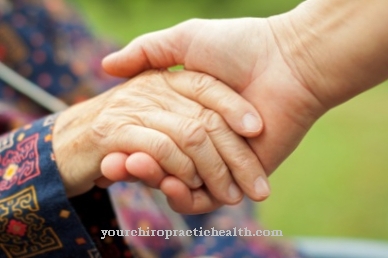The Platyspondyly is a generalized vetebra plana and thus corresponds to the reduction in height of vertebral bodies, whether acquired or congenital. The acquired form is mostly due to herniated discs or tumors and the congenital mostly to dysplasia. Therapy is often conservative using a brace.
What is platyspondyly?

© bilderzwerg - stock.adobe.com
The bony elements of the spine are called vertebrae and have a characteristic shape and height. Vetebra plana is a pathological flattening that affects a solitary vertebral body. If several vertebrae of the spinal column are flattened and thus have a decrease in height, we speak of platyspondyly.
This is a generalized vetebra plana that can be either congenital or acquired. Platyspondyly does not in itself correspond to a disease of its own, but rather to a symptom. The congenital forms occur in the context of so-called skeletal dysplasias and manifest themselves as a wide variety of symptom complexes.
The acquired form of generalized vertebral flattening is often associated with an enlargement of the intervertebral discs and can thus be attributed, for example, to a herniated disc and the resulting increase in volume of the intervertebral discs.
In platyspondyly, generalized flat vertebrae or flat vertebrae are sometimes used. The therapeutic steps differ greatly between the acquired and innate forms of the phenomenon. Therefore, research into the causes of platyspondyly is of great clinical relevance.
causes
Platyspondyly can be a congenital phenomenon in the context of various symptom complexes, which are usually skeletal dysplasias. If the manifestation occurs immediately after birth or in infancy, the primary causes are achondroplasias, diastrophic dysplasias, or thanatophoric dysplasias.
In addition, the congenital form characterizes cogenital spondyloepiphyseal dysplasia and hypophosphatasia as well as syndromes such as Goldblatt or Cushing's syndrome. The flat vertebrae are particularly pronounced in infancy in the context of metatrophic and pondyloepimetaphyseal dysplasias. In the case of hypothyroidism, the flattening only becomes more pronounced over the years.
If the cause of the flattening is congenital, but the manifestation only occurs in older children, other clinical pictures come into question as primary diseases. These diseases include osteogenesis imperfecta, mucopolysaccharidosis type IV, homocystinuria and chondrodystrophy. In addition, polytopic dysostosis, Dreyfus or Pyle syndrome, and progressive pseudorheumatoid or arthropathy may be associated with flat vertebral manifestations in later childhood.
Non-generalized but multiple flat vertebrae also occur in Kniest dysplasia, Arthro-Ophthalmopathy-Stickler syndrome, dysosteosclerosis and Dyggve-Melchior-Clausen syndrome. Acquired forms of platyspondyly, in addition to herniated discs, are most frequently associated with tumor metastases.
The flattening of the vertebrae manifests itself mainly on the middle or lower thoracic spine due to the increased force applied in this area. When platyspondyly affects the lumbar spine, it is often associated with kyphosis. In kyphosis, the lumbar spine assumes a convex curve. Chronic pain, sleep disorders, organ disorders and sensory disorders are conceivable accompanying symptoms of this phenomenon.
In individual cases, psychological problems such as depression also occur. In addition, patients with platyspondyly often suffer from postural weakness, regardless of the underlying disease. Depending on the location of the generalized flattening, neurological deficits such as motor disorders can also occur. The other symptoms depend heavily on the cause in each individual case.
Congenital platyspondyly is usually associated with multiple dysplasias of the skeleton, such as those present in the syndromes and dysplasia complex mentioned above. The acquired form due to tumor symptoms can be characterized by a progressive course, which in individual cases can progress to paraplegia.
You can find your medication here
➔ Medicines for painDiseases with this symptom
- Cushing syndrome
- Achondroplasia
- Metastases
- Chronic pain
- heatstroke
- Pyle syndrome
- Paraplegia
- Vitreous bone disease
- Pycnodysostosis
- Morquio's disease
- Kniest dysplasia
- Skeletal dysplasia
Diagnosis & course
X-ray imaging is particularly helpful for the doctor in the diagnosis. The flattening of the vertebrae is documented by means of an X-ray and the underlying disease is determined by differential diagnosis. In terms of anamnestic, the time of occurrence and the familial presence of underlying diseases are particularly relevant for research into the cause.
Platyspondyly must also be distinguished from isolated height reductions due to inflammatory processes by means of imaging. The prognosis for patients with platyspondyly depends on the underlying cause. Tumor-associated flattened vertebrae have a rather unfavorable prognosis. In the context of a herniated disc, the prognosis is more favorable.
Complications
Platyspondyly occurs primarily in the context of congenital malalignments of the skeleton. The stunting of the vertebral bodies leads to deformations of the spine. Those affected suffer from severe pain and sleep disorders, as well as breathing problems. In addition, there are often disorders of individual organs that are anatomically close to the spine.
In addition, the spinal nerves can also be affected, so that symptoms similar to those of a herniated disc can occur. Motor and sensitive disorders are therefore also conceivable. Achondroplasia is one of the most common causes of platyspondyly. Those affected are mostly of short stature and have shortened arms and legs, so that the quality of life is severely restricted.
In addition, motor skills develop only very slowly, but no impairment of intelligence can be observed. In addition, the disease often leads to colds and poor posture. In addition, there are paralysis and a head of water. The disease is inherited genetically, so that children can also suffer from achondroplasia.
Another bone disease that can be associated with platyspondyly is glass bone disease (osteogenesis imperfecta). Affected people have very brittle bones that tend to fracture with the slightest vibration. In addition, patients are mostly dependent on wheelchairs, so that the quality of life is severely impaired.
When should you go to the doctor?
Platyspondyly always requires treatment. If the information is positive, a specialist should be consulted immediately to initiate proper treatment. However, it is questionable whether a visit to the doctor is necessary even if there is mere suspicion. This depends on the individual case and cannot therefore be answered across the board. Basically, however, an orientation based on the level of suspicion is helpful.
Anyone who, based on tangible facts, believes they are suffering from platyspondyly should definitely consult an orthopedic surgeon. A reliable diagnosis can only be made by a specialist. Even a family doctor will not be able to make a definitive diagnosis because he does not have the technical aids (e.g. X-ray machine) necessary to make a diagnosis. Inaction leads to ignorance and thus uncertainty. Tangible facts are present when specific symptoms of platyspondyly are shown.
Anyone who has a suspicion without being able to support it with concrete circumstances can first contact a family doctor. This can confirm or refute the suspicion. If necessary, he will refer you to an orthopedic surgeon or other specialist.
Doctors & therapists in your area
Treatment & Therapy
Treatment for platyspondyly depends on the root cause of the vertebral changes. Genetic causes cannot be eliminated. In the context of familial dysplasias, platyspondyly can therefore only be treated symptomatically. This symptomatic treatment can, for example, correspond to therapy using a clinical brace.
Such therapeutic steps are conservative measures and can bring about a reduction in symptoms in both congenital and acquired platyspondyly. In both cases, adequate pain therapies using medication can be used to combat the pain. Sometimes opiate patches are also used.
The symptomatic therapy of platyspondyly is thus divided into internal measures of pain therapy and external stabilization measures, which are usually carried out in the form of long-term therapy. In acute cases, bed rest can alleviate the acute symptoms. Surgical treatment is used for acquired forms of platyspondyly caused by tumor metastases.
The affected areas are cleared out and vertebral body replacements are used. Depending on the accompanying symptoms, physiotherapy can counteract postural weaknesses or motor deficits in individual cases.
Outlook & forecast
In platyspondyly, the patient's vertebrae are primarily deformed and deformed. The curvature of the vertebrae also puts pressure on the spine, causing severe pain. These occur mainly during sleep, so that it is not uncommon for those affected to experience sleep disorders. These have a negative effect on the mood and physical condition of the patient and can greatly reduce the quality of life.
Most people with platyspondyly are short of stature. This symptom also restricts life. Due to platyspondyly, patients often suffer from flu and colds and from the symptom of the water head. Platyspondyly often occurs together with vitreous bone disease and can also put a heavy strain on the patient's life. Those affected depend on the help of other people or on the use of crutches and wheelchairs.
The platyspondyly cannot be completely cured. However, the symptoms can be limited so that everyday life is made bearable for the patient. Physiotherapy is particularly helpful here.
You can find your medication here
➔ Medicines for painprevention
Acquired platyspondyly from a slipped disc can be prevented by taking steps such as weight loss, exercise, posture training, and proper lifting and carrying. There are no promising preventive measures for platyspondylia in the context of genetic dysplasias and syndromes.
You can do that yourself
In accordance with the fact that there is no cure for the congenital form of this spinal abnormality, the self-help measures are also designed purely for the treatment of symptoms and the slight improvement in individual living conditions. The sequelae of platyspondyly and the other physical circumstances of those affected are decisive. This also applies to people with acquired platyspondyly. With them, however, the situation is easier to overlook due to the lack of existing symptom complexes and physiotherapeutic measures in particular are more promising, because they can be carried out without restrictions due to further symptoms and malformations.
In this way, those affected can take physiotherapeutic measures that can be managed within the framework of their physical limitations. In this way, further deterioration in posture can be counteracted. Affected people can also learn certain movement sequences that cause less pain or are more efficient. Such physiotherapeutic measures are usually in the form of long-term therapy. Maintaining physical abilities can also be supplemented by exercises at home.
Since platyspondyly leads to pain and sleep problems, those affected can obtain relief by means of various measures. Relaxing baths, using essential oils, or consuming herbal pain relievers can provide relief. In the case of acute episodes of pain, an equally acute bed rest usually helps.
























.jpg)



